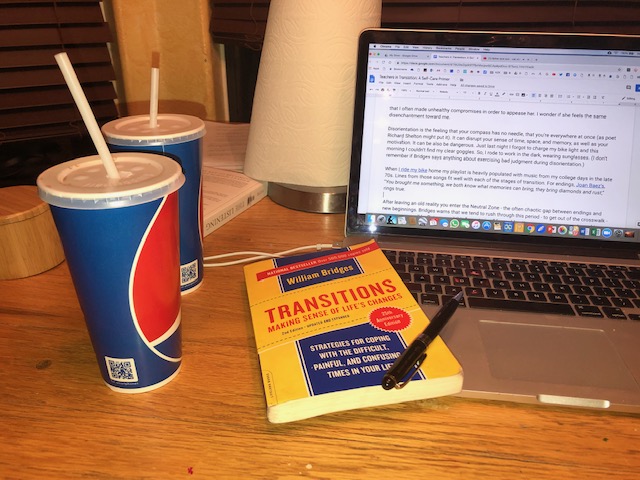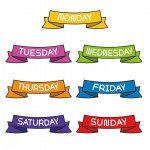The following was written with gratitude to restorative practices expert, Monica Kaminski.
I bet you can name a close colleague to whom you’ve lent a gentle ear as they transitioned to a new professional or personal identity. Maybe they were psyched and ready to go; maybe they were surfing the stages of grief. Likely you’ve been there yourself.
Teachers live lives of transition. So, it’s odd that so few are familiar with the process. For example, you might know that transitions begin with an ending and end with a beginning. But have you ever thought about the importance of the gap between the two?
If not, consider spending some time with Transitions: Making Sense of Life’s Changes, by William Bridges.
The first part of his book, The Need for Change, explains that without transitions, we would never grow from youthful dependencies to independence to interrelatedness, and finally to a mature mix of the last two. He illustrates his narrative with examples from the Oedipus and Odysseus stories and has a chapter each on the features of relationships in transition and transitions in the workplace.
The second half of the book, The Transition Process Itself, describes the concrete work it takes to move through the stages of Endings, the Neutral Zone, and New Beginnings, and that’s where I’ll focus.
Endings involve five steps: disengagement, dismantling, disidentification, disenchantment, and disorientation which may occur simultaneously or in any order. The steps tend to be more outward and cognitive as compared to the well known stages of grieving (denial, anger, bargaining, depression, acceptance).
Disengagement means stopping the former “signals and cues” that helped us “pattern our behavior.” When my friend Jessica Harris became principal at a new school, I predicted she would accidentally call her new students “Huskies” – the mascot of her former school. Sure enough, a few weeks into the new year, she let me know that all day she had been doing just that. She hadn’t fully disengaged from her previous role.
Dismantling is the process of separating – cognitively, physically, and emotionally – from what’s being left behind. For a divorcing teacher, dismantling would include finding a new habitation and the end of love.
Disidentification is the often painful loss of the labels by which we define ourselves. But Bridges writes that the work is important to, “… loosen the bonds of the person we think we are so that we can go through a transition toward a new identity.” A teacher who moves out of the classroom, but still finds ways to rationalize keeping the title of “teacher” is struggling with disidentification.
During disenchantment, we face the fact that much of what we thought was real was really just thought. It’s an understanding that our former enchantment was, “…a spell cast by the past on the present.” I remember a former colleague with whom I thought I worked well. Then, with time, realized that I often made unhealthy compromises in order to appease her. I wonder if she feels the same disenchantment towards me.
Disorientation is the feeling that your compass has no needle, that you’re everywhere at once (as poet Richard Shelton might put it). It can disrupt your sense of time, space, and memory, as well as your motivation. It can be also be dangerous. Just last night I forgot to charge my bike light and this morning I couldn’t find my clear goggles. So, I rode to work in the dark, wearing dark goggles. (I don’t remember if Bridges says anything about exercising bad judgment during disorientation.)
When I ride my bike home my playlist is heavily populated with music from my college days in the late 70s. Lines from those songs fit well with each of the stages of transition. For endings, Joan Baez’s, “You brought me something, we both know what memories can bring, they bring diamonds and rust,” nails it.
After the work of endings, you enter the Neutral Zone – the often chaotic gap between endings and new beginnings. Bridges warns that we tend to rush through this period – to get out of the crosswalk – as soon as possible. But we need this “moratorium” from old patterns as we grow accustomed to new signals and cues.
In the neutral zone, people tend to find ways to be alone and appear to be rambling through their days. But Bridges writes, “Only in the apparently aimless activity of your time alone can you do the important inner business of self-transformation.” It’s best to embrace this time which is, “…essentially a death and rebirth rather than one of mechanical modification.” As such, the neutral zone is the fountain of renewal.
Bridges offers suggestions for reducing the amount of time it takes to move through the neutral zone, the most sobering of which is, “…thinking what would be unlived if you’re life had ended today.”
Concluding this section, Bridges makes the need for neutral zone explicit. It is the time when, “We are making the imperceptible shift from one season of life to the next.”
John Lennon’s chorus from “Watching the Wheels” seems about right for the neutral zone:
I’m just sitting here watching the wheels go round and round
I really love to watch them roll
No longer riding on the merry-go-round
I just had to let it go.
Completing the neutral zone, you enter a New Beginning, which is not just wearing a new title. Rather it is the adoption of the new self through the reversal of the steps of endings discussed above. Bridges suggests there may be false starts and that the question we must resolve is whether an opportunity is an authentic beginning we want to follow, or a “beginning” that amounts to deferring an ending or the time in the neutral zone.
But Bridges has learned in his work that, “When we are ready to make a new beginning, we will shortly find an opportunity.” He adds that the opportunity may present itself subtly, a “faint intimation of something different.” People he has worked with describe the first hint as an “idea” or an “impression” or an “image.” Regardless, to borrow his metaphor, if the key is right, it will unlock the door. Otherwise, there’s still neutral zone work to be done.
Bridges offers specific advice if everything indicates that you’re moving out of the neutral zone. First of all, “Stop getting ready and act.” Then, imagine what it’s going to be like when at last you’re the new you. Finally, take things systematically and avoid tempting shortcuts. He also cautions against being too results oriented at first – setbacks in no way mean you’re on the wrong path.
Bridges describes a true beginning as a homecoming in which we connect our new identity with elements of our old one. As dazzling as it can feel, he uses a Zen saying to express the need to keep our feet on the ground: “After enlightenment, the laundry.”
On my ride home today, in the light pink light of the fading day, Jim Croce’s I’ve Got a Name landed on my playlist, and I think the whole song is perfect for New Beginnings. But the lines that echo most in my mind are:
Like the fool I am and I’ll always be
I’ve got a dream, I’ve got a dream
They can change their minds but they can’t change me
I’ve got a dream, I’ve got a dream.
And I’m going to go there free.










Comments 3
I NEEDED this article and didn’t know it. This is the most important ed. blog I’ve ever read. Thank you for writing this and for doing it so eloquently. I’ll look into this book.
I actually thought of you (among others) as I was writing. Thank you for the compliment.
Sandy this is deep. I really love what you write amigo. I am reading this as I am watching some of my friends go thru major transitions and your article hits it on the head.